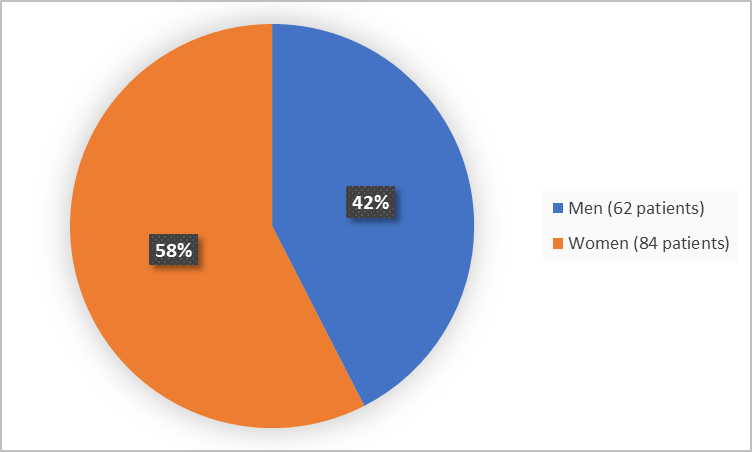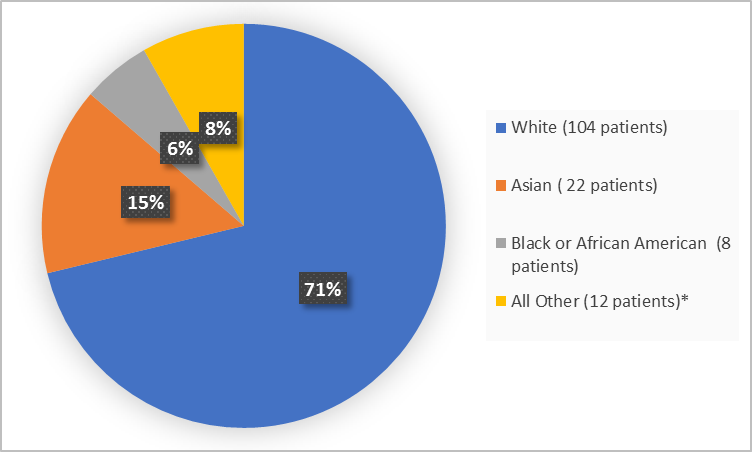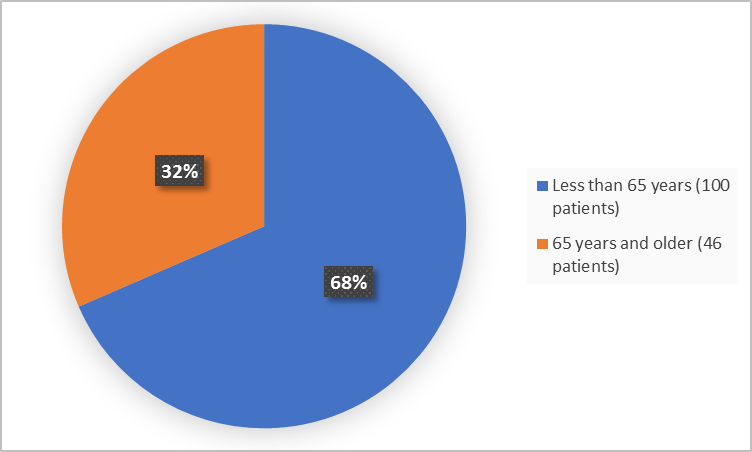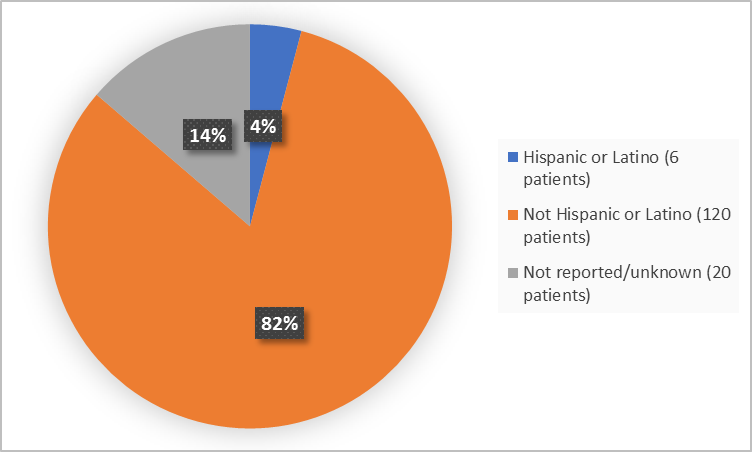Drug Trials Snapshot: PEMAZYRE
HOW TO USE THIS SNAPSHOT
The information provided in Snapshots highlights who participated in the clinical trials that supported the FDA approval of this drug, and whether there were differences among sex, race and age groups. The “MORE INFO” bar shows more detailed, technical content for each section. The Snapshot is intended as one tool for consumers to use when discussing the risks and benefits of the drugs.
LIMITATIONS OF THIS SNAPSHOT
Do not rely on Snapshots to make decisions regarding medical care. Always speak to your health provider about the risks and benefits of a drug. Refer to the PEMAZYRE Package Insert for complete information.
PEMAZYRE (pemigatinib)
(pemah zeer)
Incyte Corporation
Approval date: April 17, 2020
DRUG TRIALS SNAPSHOT SUMMARY:
What is the drug for?
PEMAZYRE is a drug used for treatment of adults with bile duct cancer (cholangiocarcinoma) that has spread to other parts of the body (metastatic) or cannot not be removed by surgery. It should be used in patients who have been previously treated with chemotherapy and whose cancer has a certain type of abnormality in the FGFR2 gene.
How is this drug used?
PEMAZYRE is a tablet taken by mouth once a day for 14 days followed by 7 days off treatment to complete a 21-day treatment cycle.
What are the benefits of this drug?
In the trial, 38 of 107 patients (36%) treated with PEMAZYRE achieved partial or complete shrinkage of the tumor (overall response rate). Of these patients, 63% had a cancer shrinkage lasting 6 months or longer and 18% had it lasting 12 months or longer.
PEMAZYRE was approved under FDA’s accelerated approval program, which provides earlier patient access to a promising new drug while the company continues to conduct clinical trials to confirm that the drug works well.
What are the benefits of this drug?
Table 1 shows efficacy results based on the overall response rate (ORR) and duration of response (DoR) as determined by an independent review committee (IRC) according to Response Evaluation Criteria in Solid Tumors (RECIST) v1.1.
Table 1. Efficacy Results
| Efficacy Parameter | PEMAZYRE N = 107 |
|---|---|
| ORR (95% CI) | 36% (27, 45) |
| Complete response | 2.8% |
| Partial response | 33% |
| Median DoR (months) (95% CI)a | 9.1 (6.0, 14.5) |
| Patients with DoR ≥ 6 months, n (%) | 24 (63%) |
| Patients with DoR ≥ 12 months, n (%) | 7 (18%) |
aThe 95% confidence interval (CI) was calculated using the Brookmeyer and Crowley's method.
Note: Data are from IRC per RECIST v1.1, and complete and partial responses are confirmed.
PEMAZYRE Prescribing Information
Were there any differences in how well the drug worked in clinical trials among sex, race and age?
- Sex: PEMAZYRE worked similarly in men and women.
- Race: The majority of patients were White, therefore difference in how well the drug worked between races could not be determined.
- Age: PEMAZYRE worked similarly in patients above and below 65 years of age.
Were there any differences in how well the drug worked in clinical trials among sex, race, and age groups?
The table below summarizes efficacy results by relevant demographic subgroups.
Table 2. ORR per RECIST 1.1 as Assessed by IRC for Subgroups
| Characteristics (n) N=107 |
Response Rate (95% CI) |
|---|---|
| Sex | |
| Men (42) | 31 (18, 47) |
| Women (65) | 38 (27, 51) |
| Race | |
| White (79) | 34 (24, 46) |
| All Other (28) | 39 (22, 59) |
| Age Group | |
| < 65 years (82) | 34 (24, 45) |
| ≥ 65 years (25) | 40 (21, 61) |
| Region | |
| United States (64) | 36 (24, 49) |
| Other (43) | 35 (21, 51) |
CI=confidence interval
FDA Review
What are the possible side effects?
PEMAZYRE may cause serious side effects including detachment of retina (inner layer of the eye), increased phosphate level in the blood, and harm to unborn baby.
The most common side effects of PEMAZYRE are increased phosphate level in the blood, hair loss, diarrhea, nail changes, fatigue, change of taste sense, and nausea.
What are the possible side effects (results of trials used to assess safety)?
Table 3 summarizes adverse reactions that occurred in ≥15% of patients treated with PEMAZYRE.
Table 3. Adverse Reactions in ≥15% of Patients Who Received PEMAZYRE
| PEMAZYRE N=146 |
||
|---|---|---|
| Adverse Reaction | All Gradesa (%) |
Grades ≥ 3* (%) |
| Metabolism and nutrition disorders | ||
| Hyperphosphatemiab | 60 | 0 |
| Decreased appetite | 33 | 1.4 |
| Hypophosphatemiac | 23 | 12 |
| Dehydration | 15 | 3.4 |
| Skin and subcutaneous tissue disorders | ||
| Alopecia | 49 | 0 |
| Nail toxicityd | 43 | 2.1 |
| Dry skin | 20 | 0.7 |
| Palmar-plantar erythrodysesthesia syndrome | 15 | 4.1 |
| Gastrointestinal disorders | ||
| Diarrhea | 47 | 2.7 |
| Nausea | 40 | 2.1 |
| Constipation | 35 | 0.7 |
| Stomatitis | 35 | 5 |
| Dry mouth | 34 | 0 |
| Vomiting | 27 | 1.4 |
| Abdominal pain | 23 | 4.8 |
| General disorders | ||
| Fatigue | 42 | 4.8 |
| Edema peripheral | 18 | 0.7 |
| Nervous system disorders | ||
| Dysgeusia | 40 | 0 |
| Headache | 16 | 0 |
| Eye disorders | ||
| Dry eyee | 35 | 0.7 |
| Musculoskeletal and connective tissue disorders | ||
| Arthralgia | 25 | 6 |
| Back pain | 20 | 2.7 |
| Pain in extremity | 19 | 2.1 |
| Infections and infestations | ||
| Urinary tract infection | 16 | 2.7 |
| Investigations | ||
| Weight loss | 16 | 2.1 |
*Only Grades 3 – 4 were identified.
a Graded per NCI CTCAE 4.03.
b Includes hyperphosphatemia and blood phosphorous increased; graded based on clinical severity and medical interventions taken according to the "investigations-other, specify" category in NCI CTCAE v4.03.
c Includes hypophosphatemia and blood phosphorous decreased.
dIncludes nail toxicity, nail disorder, nail discoloration, nail dystrophy, nail hypertrophy, nail ridging, nail infection, onychalgia, onychoclasis, onycholysis, onychomadesis, onychomycosis, and paronychia.
e Includes dry eye, keratitis, lacrimation increased, pinguecula, and punctate keratitis.
PEMAZYRE Prescribing Information
Were there any differences in side effects among sex, race and age?
- Sex: The occurrence of side effects was similar in men and women.
- Race: The majority of patients were White, therefore differences in the occurrence of side effects among races could not be determined.
- Age: The occurrence of side effects was similar in patients above and below 65 years of age.
Were there any differences in side effects of the clinical trials among sex, race, and age groups?
Analyses of side effects by subgroups are presented below.
Table 4. Summary of Adverse Events (AEs) by Sex
| Adverse Reaction | PEMAZYRE N=146 |
|
|---|---|---|
| Men N = 62 n(%) |
Women N = 84 n (%) |
|
| All-Grade AEs | 62 (100) | 84 (100) |
| Grade 3-5 AEs | 39 (63) | 54 (64) |
Table 5. Summary of Adverse Events (AEs) by Race
| Adverse Reaction | PEMAZYRE N=146 |
||
|---|---|---|---|
| White N = 104 n(%) |
Asian N = 22 n (%) |
All Other N = 20 n(%) |
|
| All-Grade AEs | 104 (100) | 22 (100) | 20 (100) |
| Grade 3-5 AEs | 70 (67) | 12 (55) | 11 (55) |
Table 6. Summary of Adverse Events (AEs) by Age
| Adverse Reaction | PEMAZYRE N=146 |
|||
|---|---|---|---|---|
| < 65 y N = 100 n(%) |
>= 65 y N = 46 n (%) |
< 75 y N = 135 n(%) |
>= 75 y N = 11 n(%) |
|
| All-Grade AEs | 100 (100) | 46 (100) | 135 (100) | 11 (100) |
| Grade 3-5 AEs | 58 (58) | 35 (76) | 86 (64) | 7 (64) |
| SAEs | 39 (39) | 26 (57) | 59 (44) | 6 (55) |
SAEs=serious adverse events
Adapted from FDA Review and data from FDA safety team.
WHO WAS IN THE CLINICAL TRIALS?
Who participated in the trials?
The FDA approved PEMAZYRE based on evidence from one clinical trial (NCT02924376) of 146 patients with previously treated, locally advanced or metastatic bile duct cancer. The trial was conducted at 67 sites in the United States, Europe, and Asia.
Figure 1 summarizes by sex how many patients were in the clinical trial.
Figure 1. Baseline Demographics by Sex (safety population)
Adapted from FDA Review
Figure 2 summarizes patients by race in the clinical trial.
Figure 2. Baseline Demographics by Race (safety population)
*includes American Indian or Alaska Native, Other and Missing
Adapted from FDA Review
Figure 3 summarizes patients by age in the clinical trial.
Figure 3. Baseline Demographics by Age (safety population)
Adapted from FDA Review
Figure 4 summarizes patients by ethnicity in the clinical trial.
Figure 4. Baseline Demographics by Ethnicity (safety population)
Adapted from FDA Review
Who participated in the trials?
The demographic characteristics of the safety and efficacy populations are summarized in Tables 7 and 8, respectively.
Table 7. Demographic Characteristics (Safety Population)
| Demographic Characteristics | PEMAZYRE N=146 |
|---|---|
| Sex, n (%) | |
| Men | 62 (43) |
| Women | 84 (57) |
| Race, n (%) | |
| White | 104 (71) |
| Black or African American | 8 (6) |
| Asian | 22 (15) |
| American Indian or Alaska Native |
1 (1) |
| Other | 5 (3) |
| Missing | 6 (4) |
| Age | |
| Mean years (SD) | 57 (12) |
| Median (years) | 59 |
| Min, max (years) | 26,78 |
| Age Group n (%) | |
| < 65 years | 100 (69) |
| ≥ 65 years | 46 (31) |
| Ethnicity, n (%) | |
| Hispanic or Latino | 6 (4) |
| Not Hispanic or Latino | 120 (82) |
| Not reported/unknown | 20 (14) |
| Region, n (%) | |
| United States | 89 (61) |
| Other | 57 (39) |
Clinical Trial Data
Table 8. Demographic Characteristics (Efficacy Population)
| Demographic Characteristics | PEMAZYRE N=107 |
|---|---|
| Sex, n (%) | |
| Male | 42 (39) |
| Female | 65 (61) |
| Race, n (%) | |
| White | 79 (74) |
| Black or African American | 7 (7) |
| Asian | 11(10) |
| Other | 4 (3.7) |
| Missing | 6 (6) |
| Age | |
| Mean years (SD) | 55 (12) |
| Median (years) | 56 |
| Min, max (years) | 26, 77 |
| Age Group n (%) | |
| < 65 years | 82 (77) |
| ≥ 65 years | 25 (23) |
| Ethnicity, n (%) | |
| Hispanic or Latino | 2 (2) |
| Not Hispanic or Latino | 87 (81) |
| Region, n (%) | |
| United States | 64 (60) |
| Other | 43 (40) |
FDA Review
How were the trials designed?
There was one trial that provided data for PEMAZYRE approval. The trial enrolled adult patients with bile duct cancer who had been treated previously with chemotherapy for their advanced cancer and whose tumors had a certain type of abnormality in the FGFR2 gene.
Patients received PEMAZYRE once daily by mouth for 14 consecutive days followed by 7 days off therapy. This 21-day cycle was administered until disease progression or the side effects became too toxic.
The trial measured the percentage of patients who achieved partial or complete shrinkage of their cancer and how long that shrinkage lasted (duration of response or DoR).
How were the trials designed?
There was one multi-center, open-label, single arm trial that provided data for approval of PEMAZYRE.
Enrolled patients were required to have locally advanced unresectable or metastatic cholangiocarcinoma whose disease had progressed on or after at least one prior therapy, and an FGFR2 gene fusion or other rearrangement.
Patients received PEMAZYRE in 21-day cycles at a dosage of 13.5 mg orally once daily for 14 consecutive days, followed by 7 days off therapy. PEMAZYRE was administered until disease progression or unacceptable toxicity.
The major efficacy outcome measures were overall response rate (ORR) and duration of response (DoR) as determined by an independent review committee (IRC) according to RECIST v1.1.
GLOSSARY
CLINICAL TRIAL: Voluntary research studies conducted in people and designed to answer specific questions about the safety or effectiveness of drugs, vaccines, other therapies, or new ways of using existing treatments.
COMPARATOR: A previously available treatment or placebo used in clinical trials that is compared to the actual drug being tested.
EFFICACY: How well the drug achieves the desired response when it is taken as described in a controlled clinical setting, such as during a clinical trial.
PLACEBO: An inactive substance or “sugar pill” that looks the same as, and is given the same way as, an active drug or treatment being tested. The effects of the active drug or treatment are compared to the effects of the placebo.
SUBGROUP: A subset of the population studied in a clinical trial. Demographic subsets include sex, race, and age groups.
PRESCRIBING INFORMATION




